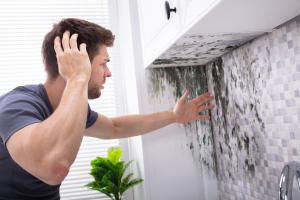
Debunking Myths About Mold Remediation
Earl Carr, Jr., president of Gulf 52 in Hammond, Louisiana, emphasizes the importance of separating fact from fiction when addressing mold issues. “Understanding the truth about mold remediation ensures that property owners can make informed decisions to protect their health and property,” Carr states.
Common Myths About Mold Remediation
Myth 1: Mold is Always Visible
One of the most persistent myths about mold is that it is always visible. Many property owners believe that if they cannot see mold, it is not a problem. However, mold often grows in hidden areas, such as behind walls, under floors, and in HVAC systems.
Fact: Mold can thrive in places that are difficult to inspect without professional tools. Hidden mold often results from water damage or high humidity levels in areas like basements, attics, or crawl spaces. Comprehensive inspections, including the use of moisture meters and infrared cameras, are necessary to identify hidden mold.
Myth 2: Bleach Kills Mold Completely
Using bleach to remove mold is a common recommendation, but it is not a comprehensive solution. While bleach may remove surface stains, it does not address the root cause of mold growth or eliminate mold in porous materials.
Fact: Bleach is ineffective for mold remediation in porous surfaces like drywall, wood, or carpeting. Mold spores can penetrate deep into these materials, and bleach cannot reach them. Proper remediation involves removing affected materials and addressing underlying moisture issues.
Myth 3: Small Amounts of Mold Are Harmless
Property owners often underestimate the potential risks of small patches of mold, believing they pose little to no threat.
Fact: Even small amounts of mold can cause health issues, particularly for individuals with allergies, asthma, or weakened immune systems. Mold spores can spread through the air, contaminating other areas of the property. Prompt removal of even small mold infestations is essential to prevent further growth and health risks.
Myth 4: Mold Only Grows After Major Water Damage
Many believe that mold growth requires significant water damage, such as flooding or burst pipes, to occur.
Fact: Mold can grow in any environment where moisture is present, even in small amounts. High humidity levels, condensation, or slow leaks are enough to create conditions for mold growth. Regular maintenance and humidity control are key to preventing mold in properties.
Myth 5: Mold Remediation Is a DIY Job
Property owners often attempt to handle mold removal themselves, believing it to be a simple cleaning task.
Fact: While small, localized mold problems may be manageable with proper precautions, most mold infestations require professional remediation. Professionals use specialized equipment and follow strict safety protocols to ensure thorough removal and prevent cross-contamination. Improper handling of mold can spread spores and exacerbate the problem.
Myth 6: Mold Problems Will Resolve Themselves Once Dry
Another common misconception is that mold will die and disappear once the area is dried.
Fact: While drying out the affected area halts active mold growth, the spores remain viable and can reactivate when moisture returns. Complete remediation involves removing mold spores and addressing moisture issues to prevent recurrence.
Myth 7: All Mold Is Toxic
The term "toxic mold" has led many to believe that all molds are harmful and dangerous.
Fact: While certain molds, such as Stachybotrys chartarum (commonly known as black mold), produce mycotoxins that can be harmful, not all molds are toxic. However, any mold can trigger allergic reactions or respiratory issues, making remediation important regardless of the type.
Myth 8: Mold Remediation Is Unaffordable
Some property owners avoid addressing mold issues due to the perception that remediation is prohibitively expensive.
Fact: While extensive mold infestations can be costly to remediate, early detection and action significantly reduce expenses. Routine maintenance and addressing minor mold issues promptly help prevent costly repairs in the future.
The Importance of Professional Mold Remediation
Professional mold remediation goes beyond surface cleaning. It involves identifying the source of moisture, safely removing contaminated materials, and restoring the affected areas to prevent future growth. Key steps in professional remediation include:
Assessment: Identifying the extent of mold contamination and the underlying causes.
Containment: Isolating the affected area to prevent the spread of mold spores.
Removal: Safely removing contaminated materials, including drywall, insulation, or carpeting.
Cleaning: Using specialized equipment and products to remove spores from surfaces and the air.
Prevention: Addressing moisture issues through repairs, dehumidification, and improved ventilation.
Prevention Tips to Minimize Mold Risks
Property owners can take proactive steps to reduce the likelihood of mold growth:
Control Humidity: Keep indoor humidity levels below 60%, ideally between 30-50%. Use dehumidifiers and air conditioners as needed.
Fix Leaks Promptly: Repair plumbing leaks, roof damage, or other water intrusions immediately.
Ensure Proper Ventilation: Use exhaust fans in kitchens, bathrooms, and laundry rooms to reduce moisture buildup.
Clean and Dry After Water Damage: Thoroughly clean and dry areas affected by water within 24-48 hours.
Inspect Regularly: Check for signs of water damage or mold growth in hidden areas like basements, attics, and crawl spaces.
Conclusion
Mold remediation is often misunderstood, with myths contributing to delays in addressing the problem. By debunking these misconceptions and prioritizing proper remediation practices, property owners can protect their health and their investments. Professional remediation ensures thorough removal and long-term prevention, providing peace of mind and a safe living environment. Recognizing the importance of accurate information and effective action is key to managing mold-related challenges successfully.
Morgan Thomas
Rhino Digital, LLC
+1 504-875-5036
email us here
Visit us on social media:
Facebook
Distribution channels: Building & Construction Industry, Culture, Society & Lifestyle, Real Estate & Property Management
Legal Disclaimer:
EIN Presswire provides this news content "as is" without warranty of any kind. We do not accept any responsibility or liability for the accuracy, content, images, videos, licenses, completeness, legality, or reliability of the information contained in this article. If you have any complaints or copyright issues related to this article, kindly contact the author above.
Submit your press release

